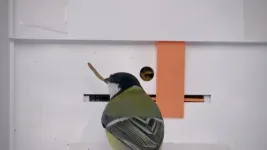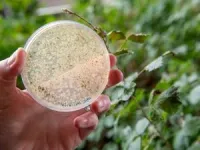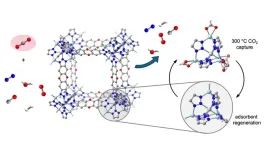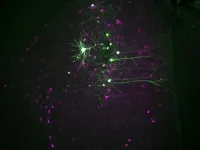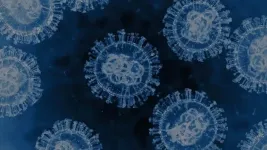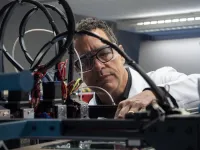(Press-News.org) Scientists have found a trigger for social learning in wild animals. An experiment on great tits has pinpointed a single factor—immigration—that can cause birds to pay close attention to others, leading them to rapidly adopt useful behaviors. The study is the first to provide experimental support of a long-held assumption that immigrants should strategically use social learning. The study, conducted by scientists from the Max Planck Institute of Animal Behavior (MPI-AB) and the Cluster of Excellence Collective Behaviour at the University of Konstanz in Germany, is published November 14 in PLOS Biology.
Many animals that live in groups learn from one another, but few wild animals have opened a window into understanding animal social learning like a single bird species: the great tits. Great tits flew to fame in the 1920s after birds started opening the foil lids of milk bottles to feed on the cream within. Residents of a small town in England were the first to report the behavior, but soon people across Europe were opening their doors to find that their milk bottles had been raided by birds. The behavior spread so far so quickly that scientists considered it unlikely that individual birds across a continent were inventing this trick on their own. Could the birds be learning from each other?
The answer remained hidden until 2015 when a team led by Lucy Aplin, then at the University of Oxford, conducted an experiment on a population of great tits in an English forest. Her experiment showed that birds were able to learn how to liberate food from a puzzle box by copying the solution from others—confirming that the original milk-raiding birds had also been passing on their thieving ways to their flock.
“Social learning is a great shortcut when it comes to safely testing new waters,” says Chimento, a postdoctoral researcher who worked in Aplin’s team at the MPI-AB. “Paying attention to what others are doing gives you the chance to see whether a new behavior is beneficial, or potentially dangerous. Copying it means that you too can reap the reward.”
By copying the behaviors of others, animals can potentially unlock resources. So Chimento and Aplin wanted to know if there was an ingredient that would catalyze social learning, allowing animals to more efficiently realize its rewards. According to theory, there was a possibility: “Theoretical models have suggested that animals should change their social learning strategy when faced with new environments,” says Chimento who is now at the Cluster of Excellence Collective Behaviour at the University of Konstanz. In other words, when animals move into a new place, they might learn more from others. “But nobody has experimentally shown this in non-human animals,” he says.
Using an automated puzzle box system they developed, the team designed an experiment to test this immigration hypothesis. They created experimental social groups of wild-caught great tits. Each group was provided a tutor which was trained to access food from a puzzle box by either pushing the door left or right. One tutor was then released into each group, so that their flock mates learned to prefer using one solution over another.
Next came the immigration event. Right-pushing birds were transferred into aviaries where resident birds were using the left-hand solution, and vice versa. Not only did immigrants see that residents were opening the puzzle box in a new way, but in some groups, the newcomers also discovered that residents scored a superior reward by doing so.
“What’s important is that the immigrants were blind to the fact that the food reward had changed,” said Chimento, the study’s lead author. “Immigrants could only know something changed by either watching the residents use the puzzle, or by trying the other side themselves.”
And watch, the immigrants did. After being released into the new aviary, the vast majority of immigrants—80 percent—switched their method immediately. Instead of attempting the method they had been trained on, the immigrants used the resident solution on their first try. Chimento says that this stark result makes a compelling case that social learning was at play: “Of course we can’t ask the birds exactly where they were getting their information from, but these behavioral patterns are striking enough to suggest that the birds were watching residents very closely from the moment they entered their new social group.”
But there was an extra twist. These immigrants were not just moved to a place where residents were getting better food; their visual world was also drastically transformed. The scientists manipulated the environment of immigrants by changing the foliage in the experimental aviaries as well.
And it was the altered visual environment that proved to be the linchpin for learning. In trials where the foliage was not changed, only 25 percent of the newcomers tried the resident solution on the first attempt, even when locals were earning better food. “They didn’t necessarily ignore the residents, but they took much longer to all switch over to the more rewarding solution. Our analyses suggested this was because they weren’t as influenced by the residents” Chimento says.
This is the first experimental evidence to show the powerful impact that immigration has on how animals learn from each other. And in the real world, this can be profound.
Says Aplin, the study’s senior author: “In nature, animals are often moving from one environment to another, so it’s helpful to have a strategy to weed out what are good and bad behaviors to use in the new place.” That’s why the theory predicted that different learning strategies should evolve to act as a filter when animals enter new environments. “Our study provided the experimental evidence to show that this is also what happens in real life,” she says.
END
Backyard birds learn from their new neighbors when moving house
Puzzle box experiment shows that after immigration, birds rapidly learn useful tricks from local experts
2024-11-14
ELSE PRESS RELEASES FROM THIS DATE:
New study in Science finds that just four global policies could eliminate more than 90% of plastic waste and 30% of linked carbon emissions by 2050
2024-11-14
Berkeley, CA/Santa Barabara, CA (14 November 2024) — A new study released in Science today determines that just four policies can reduce mismanaged plastic waste — plastic that isn’t recycled or properly disposed of and ends up as pollution — by 91% and plastic-related greenhouse gasses by one-third. The policies are: mandate new products be made with 40% post-consumer recycled plastic; cap new plastic production at 2020 levels; invest significantly in plastic waste management — such as landfills and waste collection services; and implement a small fee on plastic packaging. ...
Breakthrough in capturing 'hot' CO2 from industrial exhaust
2024-11-14
Industrial plants, such as those that make cement or steel, emit copious amounts of carbon dioxide, a potent greenhouse gas, but the exhaust is too hot for state-of-the-art carbon removal technology. Lots of energy and water are needed to cool the exhaust streams, a requirement that has limited adoption of CO2 capture in some of the most polluting industries.
Now, chemists at the University of California, Berkeley, have discovered that a porous material can act like a sponge to capture CO2 at temperatures close to those of many industrial exhaust streams. ...
New discovery enables gene therapy for muscular dystrophies, other disorders
2024-11-14
Gene therapy can effectively treat various diseases, but for some debilitating conditions like muscular dystrophies there is a big problem: size. The genes that are dysfunctional in muscular dystrophies are often extremely large, and current delivery methods can’t courier such substantial genetic loads into the body. A new technology, dubbed “StitchR,” surmounts this obstacle by delivering two halves of a gene separately; once in a cell, both DNA segments generate messenger RNAs (mRNAs) that join seamlessly together to restore expression of a protein that is missing or inactive in disease.
Published in ...
Anti-anxiety and hallucination-like effects of psychedelics mediated by distinct neural circuits
2024-11-14
New research suggests that it could be possible to separate treatment from hallucinations when developing new drugs based on psychedelics. The anti-anxiety andhallucination-inducing qualities of psychedelic drugs work through different neural circuits, according to research using a mouse model. The work is published Nov. 15 in Science.
The research shows that decoupling the beneficial effects of psychedelics from their hallucinogenic effects isn’t just a matter of chemical compound design. It’s a matter of targeted neural circuitry.
“In the past, we did this using chemistry by making new compounds, but here we focused on identifying the circuits responsible ...
How do microbiomes influence the study of life?
2024-11-14
UNIVERSITY PARK, Pa. — Microorganisms — bacteria, viruses and other tiny life forms — may drive biological variation in visible life as much, if not more, than genetic mutations, creating new lineages and even new species of animals and plants, according to Seth Bordenstein, director of Penn State’s One Health Microbiome Center, professor of biology and entomology, and the Dorothy Foehr Huck and J. Lloyd Huck Endowed Chair in Microbiome Sciences. Bordenstein and 21 other scientists from around the world published a paper in the leading journal Science, summarizing research that they said drives a deeper understanding of biological ...
Plant roots change their growth pattern during ‘puberty’
2024-11-14
Ghent, November 15, 2024 – Understanding how roots grow can help us develop plants that, for example, are more resistant to drought. Research by Prof. Bert De Rybel’s team (VIB-UGent), in collaboration with the VIB Screening Core and Ghent University, uncovers how roots go through a puberty phase, which could have important implications for developing climate-resilient agriculture. Their work appears in Science.
Plant puberty
Plants, like all living organisms, transition through various developmental stages, starting as a seed, becoming a shoot, and eventually a full-grown, fertile plant. They even go through a sort of ‘puberty’ ...
Study outlines key role of national and EU policy to control emissions from German hydrogen economy
2024-11-14
Hydrogen is set to play an important role in a future low-carbon economy. However, the hydrogen value chain comes with a set of emissions challenges that need to be addressed for hydrogen deployment to help achieve climate goals. A study prepared by the Research Institute for Sustainability – Helmholtz Centre Potsdam (RIFS) with support from Environmental Defense Fund Europe evaluates the potential impact of climate-warming emissions in Germany’s future hydrogen economy and provides recommendations for German and EU policymakers on how to avoid them.
There are hopes that hydrogen can become a carbon neutral alternative to fossil ...
Beloved Disney classics convey an idealized image of fatherhood
2024-11-14
For decades, Disney animations have shaped perceptions of family relationships and gender roles. Although much focus has traditionally been on princesses and female characters, a new study shifts attention to fatherhood and the evolving ideals of masculinity.
"In the history of Disney films, female characters and princess imagery have been widely analyzed, yet the role of masculinity has been explored far less. My research aims to deepen our understanding of the male ideals Disney has constructed and how they reflect ...
Sensitive ceramics for soft robotics
2024-11-14
Most people think of coffee cups, bathroom tiles or flower pots when they hear the word "ceramic". Not so Frank Clemens. For the research group leader in Empa's Laboratory for High-Performance Ceramics, ceramics can conduct electricity, be intelligent, and even feel. Together with his team, Clemens is developing soft sensor materials based on ceramics. Such sensors can "feel" temperature, strain, pressure or humidity, for instance, which makes them interesting for use in medicine, but also in the field of soft robotics.
Soft ceramics – how is that supposed to work? Materials ...
Trends in hospitalizations and liver transplants associated with alcohol-induced liver disease
2024-11-14
About The Study: This study found significant rate increases for alcohol-induced liver disease-related hospitalizations and liver transplants across sex and age groups between 2005 and 2021. Although older males had the highest absolute increases, the greatest relative increases occurred in younger individuals, particularly females.
Corresponding Author: To contact the corresponding author, Michele Molinari, MD, MSc, email molinarim@upmc.edu.
To access the embargoed study: Visit our For The Media website at this link ...
LAST 30 PRESS RELEASES:
Numbers in our sights affect how we perceive space
SIMJ announces global collaborative book project in commemoration of its 75th anniversary
Air pollution exposure and birth weight
Obstructive sleep apnea risk and mental health conditions among older adults
How talking slows eye movements behind the wheel
The Ceramic Society of Japan’s Oxoate Ceramics Research Association launches new international book project
Heart-brain connection: international study reveals the role of the vagus nerve in keeping the heart young
Researchers identify Rb1 as a predictive biomarker for a new therapeutic strategy in some breast cancers
Survey reveals ethical gaps slowing AI adoption in pediatric surgery
Stimulant ADHD medications work differently than thought
AI overestimates how smart people are, according to HSE economists
HSE researchers create genome-wide map of quadruplexes
Scientists boost cell "powerhouses" to burn more calories
Automatic label checking: The missing step in making reliable medical AI
Low daily alcohol intake linked to 50% heightened mouth cancer risk in India
American Meteorological Society announces Rick Spinrad as 2026 President-Elect
Biomass-based carbon capture spotlighted in newly released global climate webinar recording
Illuminating invisible nano pollutants: advanced bioimaging tracks the full journey of emerging nanoscale contaminants in living systems
How does age affect recovery from spinal cord injury?
Novel AI tool offers prognosis for patients with head and neck cancer
Fathers’ microplastic exposure tied to their children’s metabolic problems
Research validates laboratory model for studying high-grade serous ovarian cancer
SIR 2026 delivers transformative breakthroughs in minimally invasive medicine to improve patient care
Stem Cell Reports most downloaded papers of 2025 highlight the breadth and impact of stem cell research
Oxford-led study estimates NHS spends around 3% of its primary and secondary care budget on the health impacts of heat and cold in England
A researcher’s long quest leads to a smart composite breakthrough
Urban wild bees act as “microbial sensors” of city health.
New study finds where you live affects recovery after a hip fracture
Forecasting the impact of fully automated vehicle adoption on US road traffic injuries
Alcohol-related hospitalizations from 2016 to 2022
[Press-News.org] Backyard birds learn from their new neighbors when moving housePuzzle box experiment shows that after immigration, birds rapidly learn useful tricks from local experts
